Parrots are part of the order Psittaciformes, which includes over 350 bird species, including parakeets, macaws, cockatiels, and cockatoos. Because of the many species living in Australia, this article will focus on the most common parrots you may come across. Parrots are known for making loud noises and their unique, bright colors. Many of our parrots are native to Australia because these birds need to thrive in the perfect climate and habitats. Parrots are considered omnivores, consuming nuts, seeds, flowers, and insects. Let’s dive into what beautiful parrots you can find in Australia!
1. Double-eyed Fig Parrot

The Double-eyed Fig parrot is the smallest Australian parrot, only reaching up to 14 centimeters.
©Alamin-Khan/Shutterstock.com
The Double-eyed Fig parrot is green with various shades of blue and red on the face. These beautiful birds have a turquoise eye patch and a red spot on their forehead. Males have red cheeks, whereas females do not. You can spot these birds in north Queensland, New Guinea, and New South Wales. Their habitats are in open woodlands and forest edges.
2. Eclectus Parrot
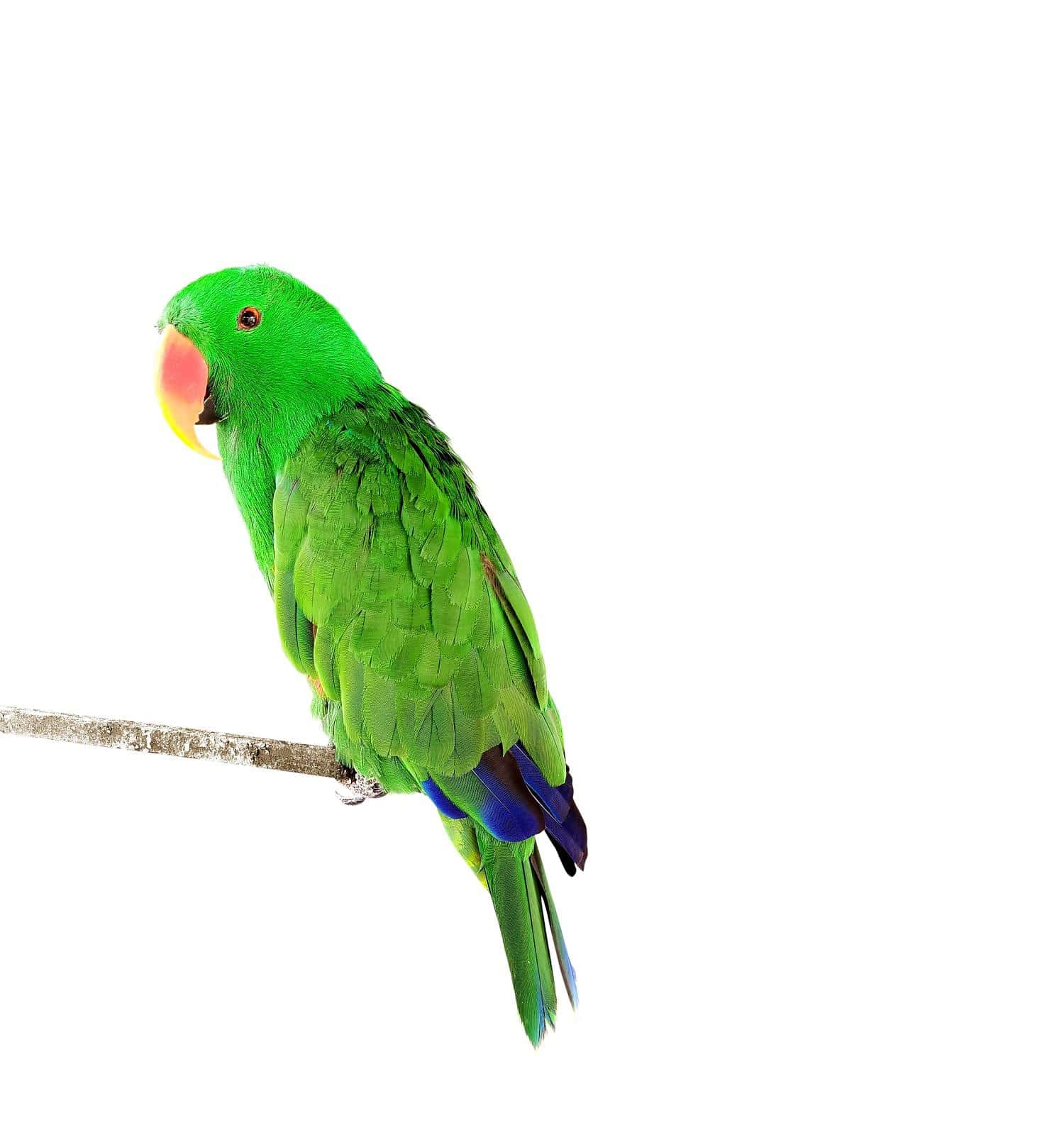
There are nine subspecies of Electus parrots.
©nopparada samrhubsuk/Shutterstock.com
The Eclectus parrot was discovered in 1913, living in the forests of north Queensland. The male Eclectus is emerald green, has red and blue underwings, and an orange beak. Female Eclectus are bright red, have dark purple coloration on the underside of their wings, and have a black beak. The average size of this parrot can range from 40 to 48 centimeters long and weigh up to 620 grams. The Eclectus parrot likes to feed on berries, fruits, and seeds.
3. Red-cheeked Parrot

The Red-cheeked parrot can grow up to 21 centimeters long and weigh 180 grams.
©spatuletail/Shutterstock.com
The Red-cheeked parrot is a stocky, short-tailed parrot first described by Johann Matthaus Bechstein in 1811. Both sexes of birds are green with red cheeks. The males have a mauve nape and head, whereas the females are duller in color with a brown head. Red-cheeked parrots live along streams and forests in northern Australia.
4. Australian King-Parrot

Australian King Parrots grow up to 43 centimeters long. They love to eat seeds and fruit.
©Adam Hanley/Shutterstock.com
The Australian King Parrot lives along the east coast of Australia, including Cooktown in Queensland and Port Campbell in Victoria. These parrots nest and eat in rainforests or wet Sclerophyll forests. Both female and male parrots have a red belly, green back, wings, and tail. Female Australian King parrots have a green, whereas males have a red head.
5. Red-winged Parrot
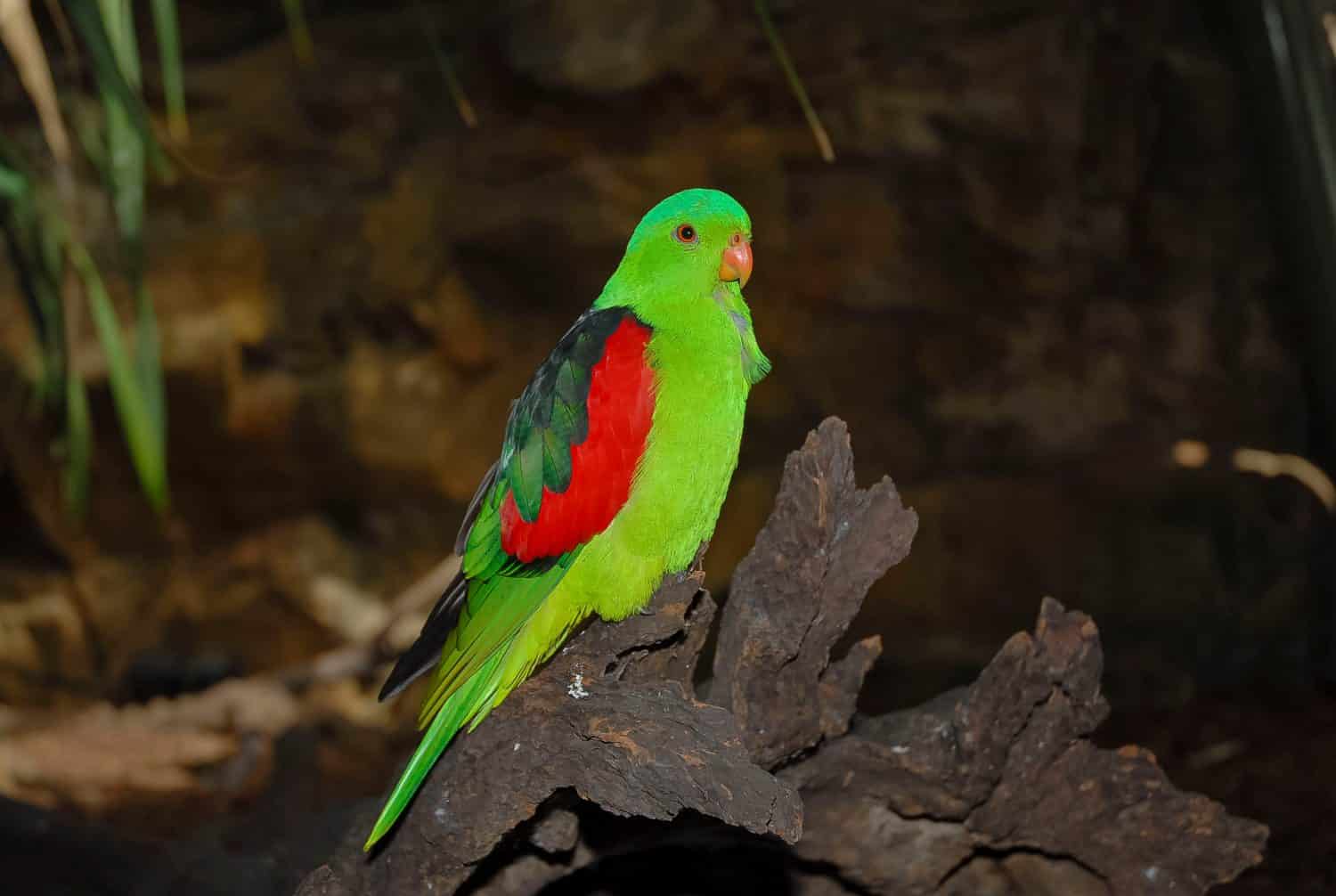
Red-winged parrots consume seeds, nectar, pollen, and insects.
©Jesus Cobaleda/Shutterstock.com
The Red-winged parrot is a medium-sized bird that grows up to 33 centimeters long. Male Red-winged parrots are primarily green with large red shoulder patches. Males also have a black back, a deep blue rump, and a yellow tip tail. Females have a dark green back, pale green tail, and a pale blue rump. These parrots live in northern and eastern Australia’s open, dry woodlands and timber-lined watercourses. This beautiful parrot can grow between 31 to 33 centimeters long.
6. Superb Parrot
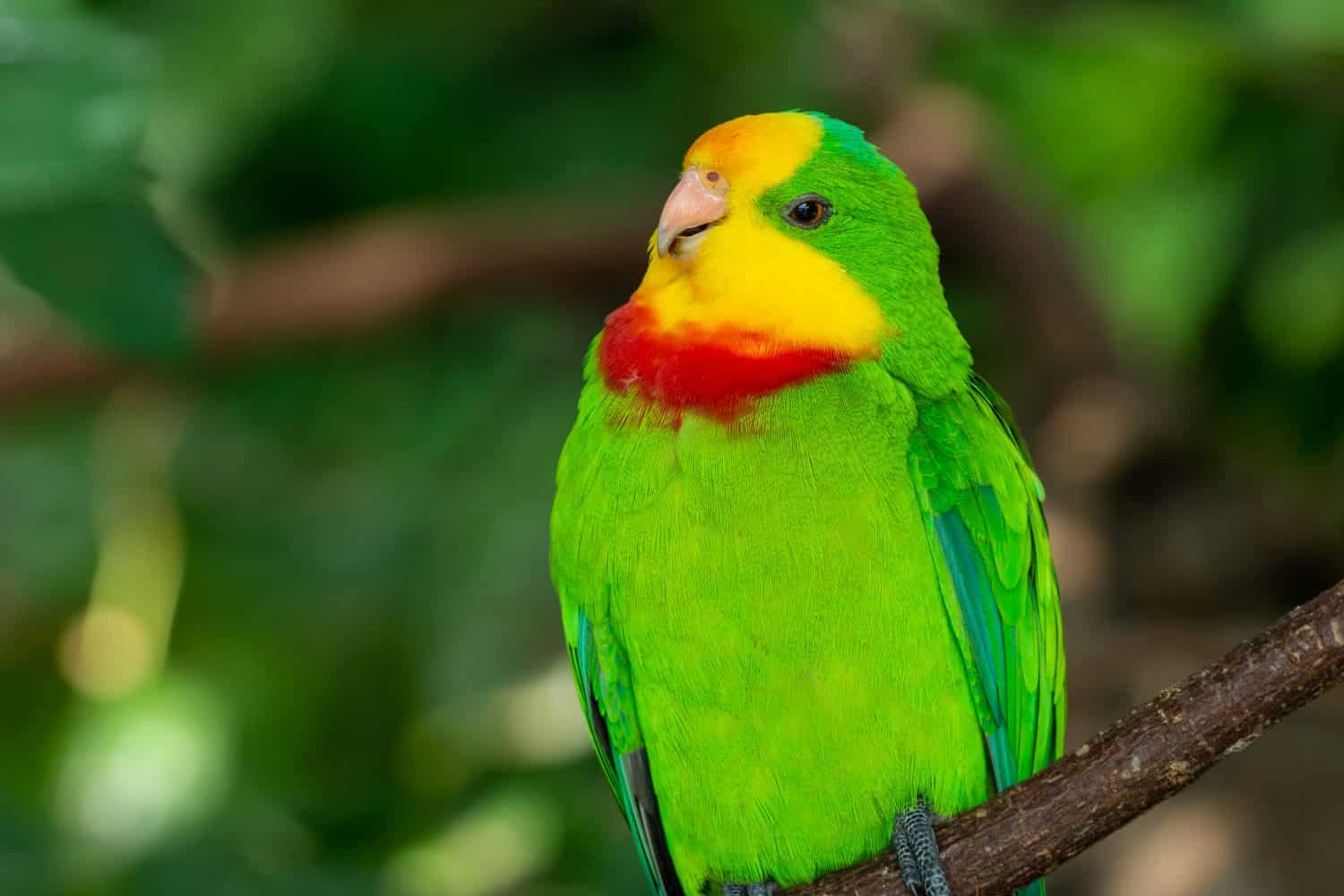
The beautiful Superb parrot is unfortunately listed as vulnerable.
©kingma photos/Shutterstock.com
Both sexes of the Superb parrot are bright green and can reach up to 40 centimeters in length. Males have a bright yellow forehead and cheeks. Females have red thighs and pink patches inside their tail feathers. These birds live in the eastern inland of New South Wales. They will nest in the tall riparian River Red Gum Forest or woodlands of Riverina.
7. Regent Parrot

Regent parrots have a 25-year lifespan and can grow up to 43 centimeters long.
©Wang LiQiang/Shutterstock.com
There are two populations of Regent parrots claiming different parts of Australia. The eastern Regent parrots live in eastern Australia’s woodlands, mallees, and floodplains, whereas the western population lives in open forests and woodlands of Australia. Male Regent parrots have a yellow body, bluish-black wings, and tail. Males also have yellow and red patches on the wings. Females are a dull olive green with pale pink patches on their wings.
8. Red-capped Parrot

Red-capped parrots can grow up to 37 centimeters and weigh between 105 to 156 grams.
©Willem Heyneker/Shutterstock.com
The Red-capped parrot has a red crown, neon green and yellow cheeks, and a rump. The breast of this bird is a bluish-purple coloration and has red undersides. You can observe these birds in the Marri, Wandoo, and Jarrah forests. Red-capped parrots tend to stay along the Eucalypt woodlands as well because their long bills are for eating Eucalypt seeds.
9. Swift Parrot

The Swift parrot is also known as the Red-faced parrot and can grow up to 25 centimeters long.
©Karel Bartik/Shutterstock.com
The Swift parrot is primarily green with a dark blue patch on its crown. They also have a crimson coloration around the beak, forehead, and throat. Females have a duller coloration and have a creamy color on the underside of their wings. These birds live in south-eastern Australia in suburban parks, gardens, and Sclerophyll forests. These birds also live around the Tasmanian Blue Gum trees of Tasmania.
10. Red-rumped Parrot
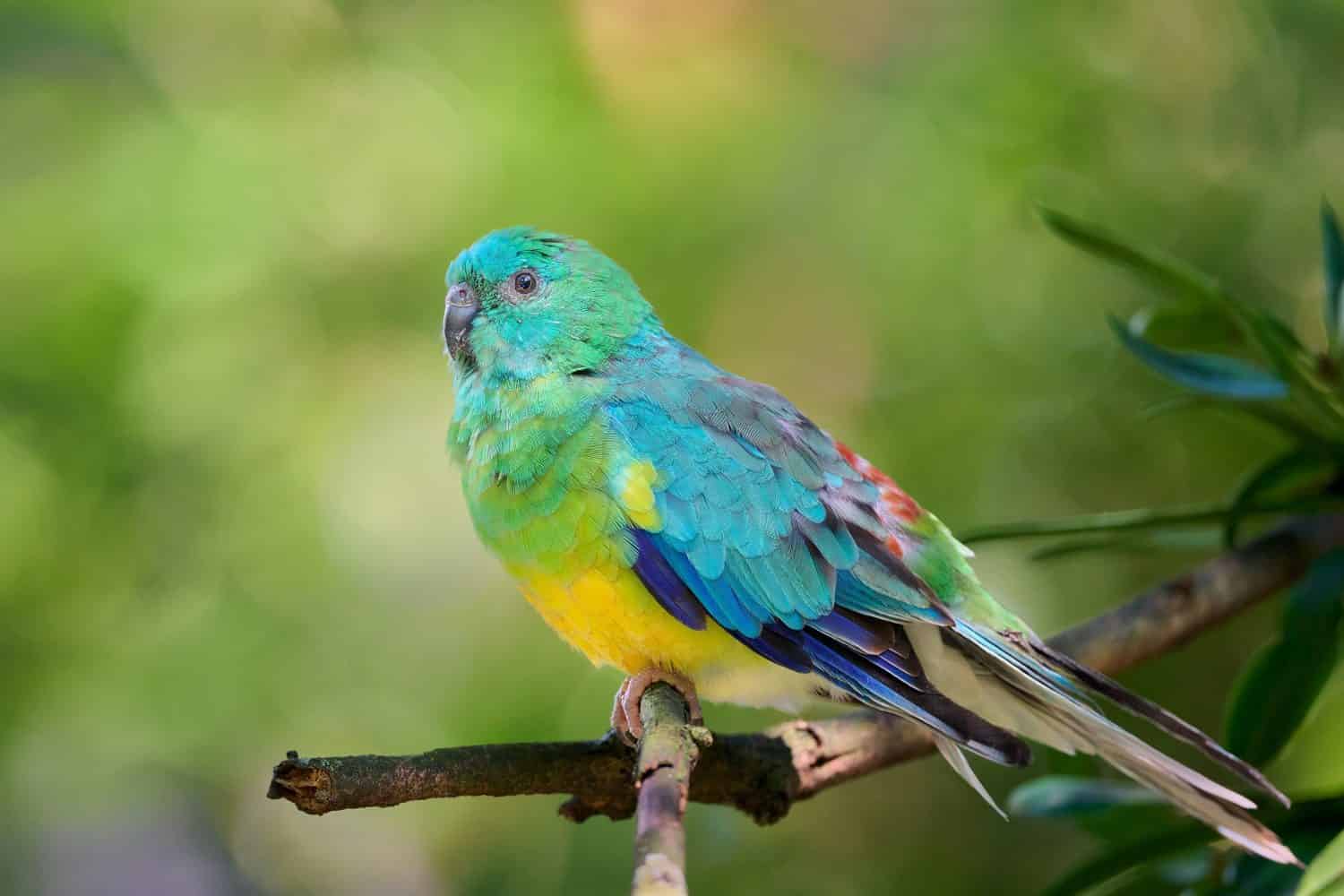
Because of their habitat choice in grasslands, they are often called the Grass Parrots.
©Alamin-Khan/Shutterstock.com
The Red-rumped parrot lives around South Queensland, Victoria, Lake Eyre Basin, and Murray-Darling Basin. The body of this parrot is emerald green with a bright green lower back. The males have a bright green chest and different shades of turquoise on their heads. Females are olive green and have darker shades of coloring on their wings. The Red-rumped parrot has a lifespan of 32 years and can grow up to 11 inches long.
Mulga Parrot
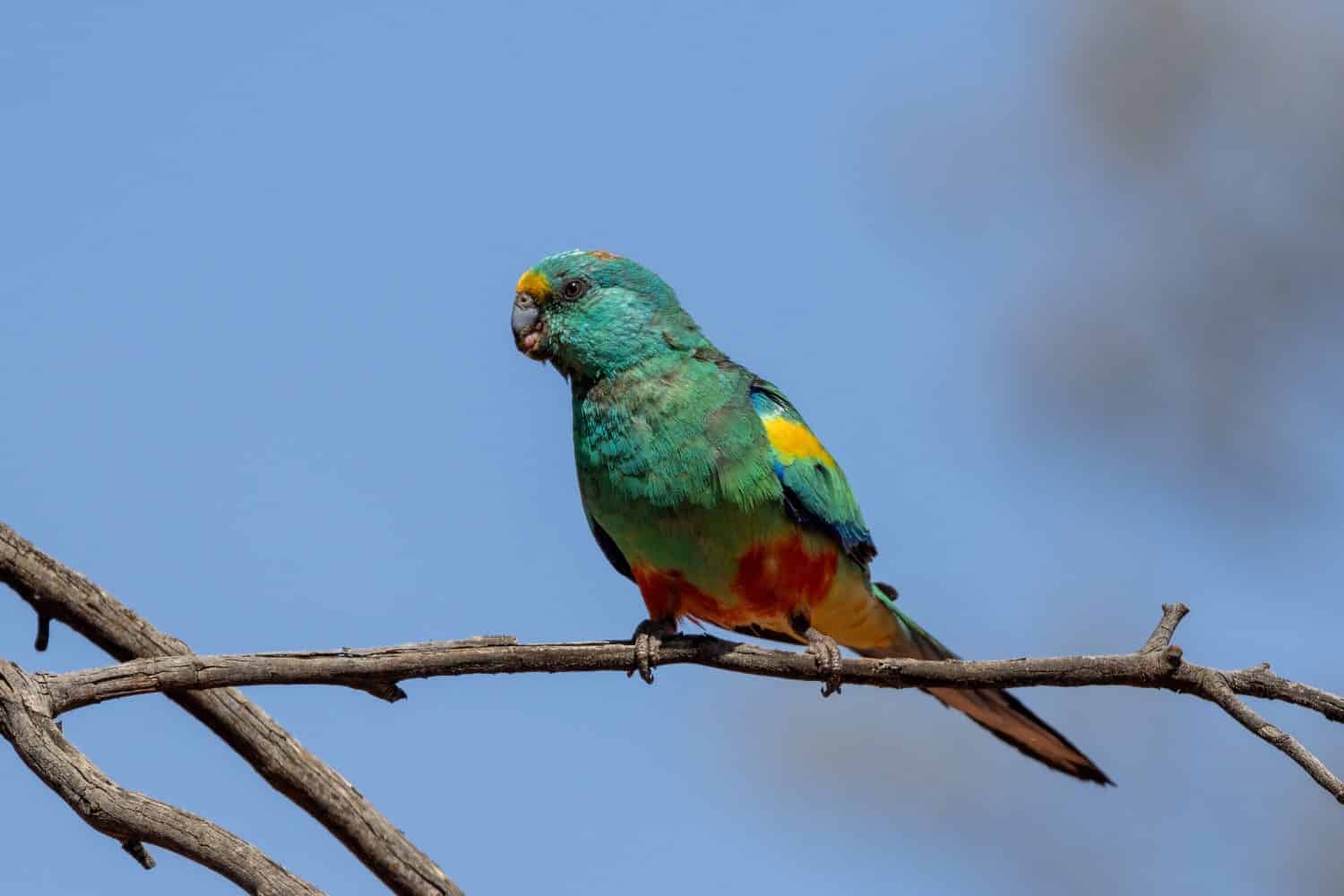
The Mulga parrots belong to a small part of the Australian
Parakeet
family.
©Ken Griffiths/Shutterstock.com
Mulga parrots live in central southern Queensland and north-western Victoria. Their habitats consist of dry or semi-dry shrublands and woodlands. These parrots are emerald green and have yellow bands across their lower foreheads. They also have a yellow patch on their shoulder, a red rump, and yellow coloration on the underside of their tails. Mulga parrots can reach up to 11 inches in length.
12. Golden-shouldered Parrot
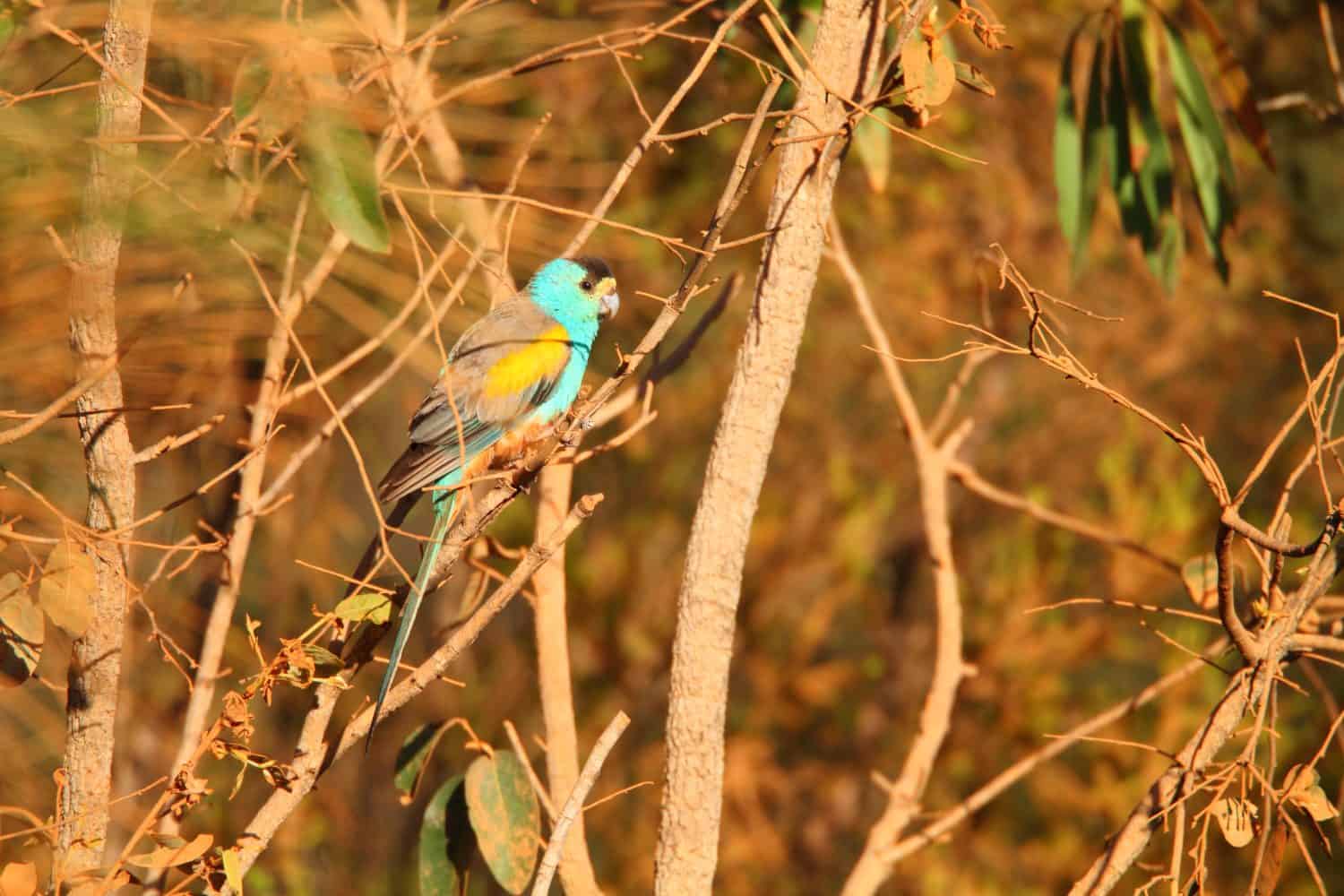
The Golden-shouldered parrot can grow up to 28 centimeters long and weigh up to 56 grams.
©feathercollector/Shutterstock.com
The Golden-shouldered parrot lives in the Southern Cape York Peninsula of Queensland. The males are blue with yellow shoulders and a black cap. The lower back is greyish-brown, and the lower belly is pink. The female golden-shoulder parrots have a charcoal grey cap and have a greenish-yellow cream coloration on the underside of their wings.
13. Bourke’s Parrot
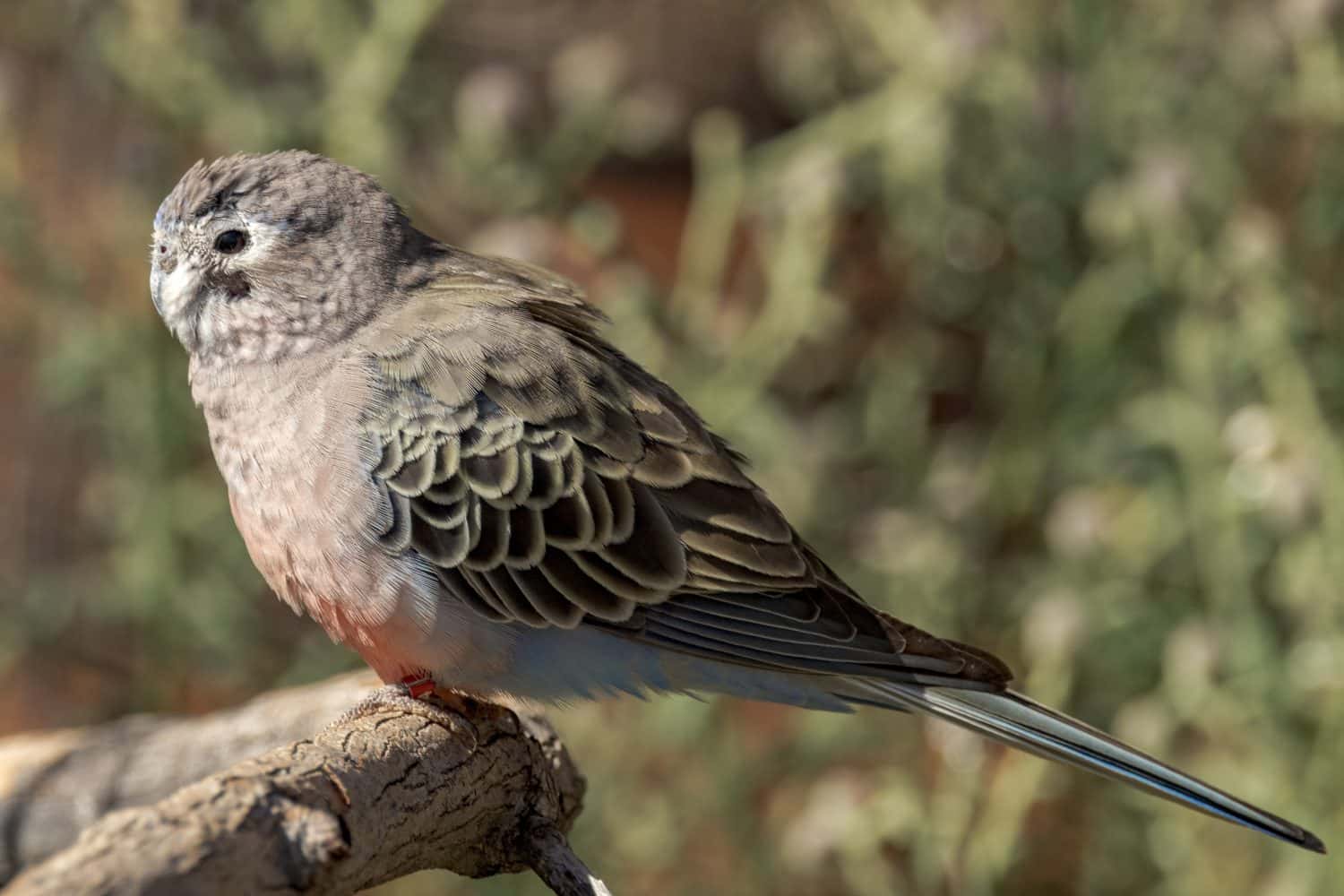
Bourke’s parrot is also known as the Night parrot because it flies into watering places at night. These beautiful parrots are 19 to 23 centimeters long.
©Imogen Warren/Shutterstock.com
Bourke’s parrots are grey and brown with light pink undersides. Around the eyes are white, giving a light-speckled appearance. Females are similar to the males but have a duller coloration. These birds live in north-western New South Wales, Queensland, and the Mid-coast of western Australia. The Bourke’s parrot lives in Mulga, acacia shrubs, and eucalypt woodlands.
14. Blue-winged Parrot
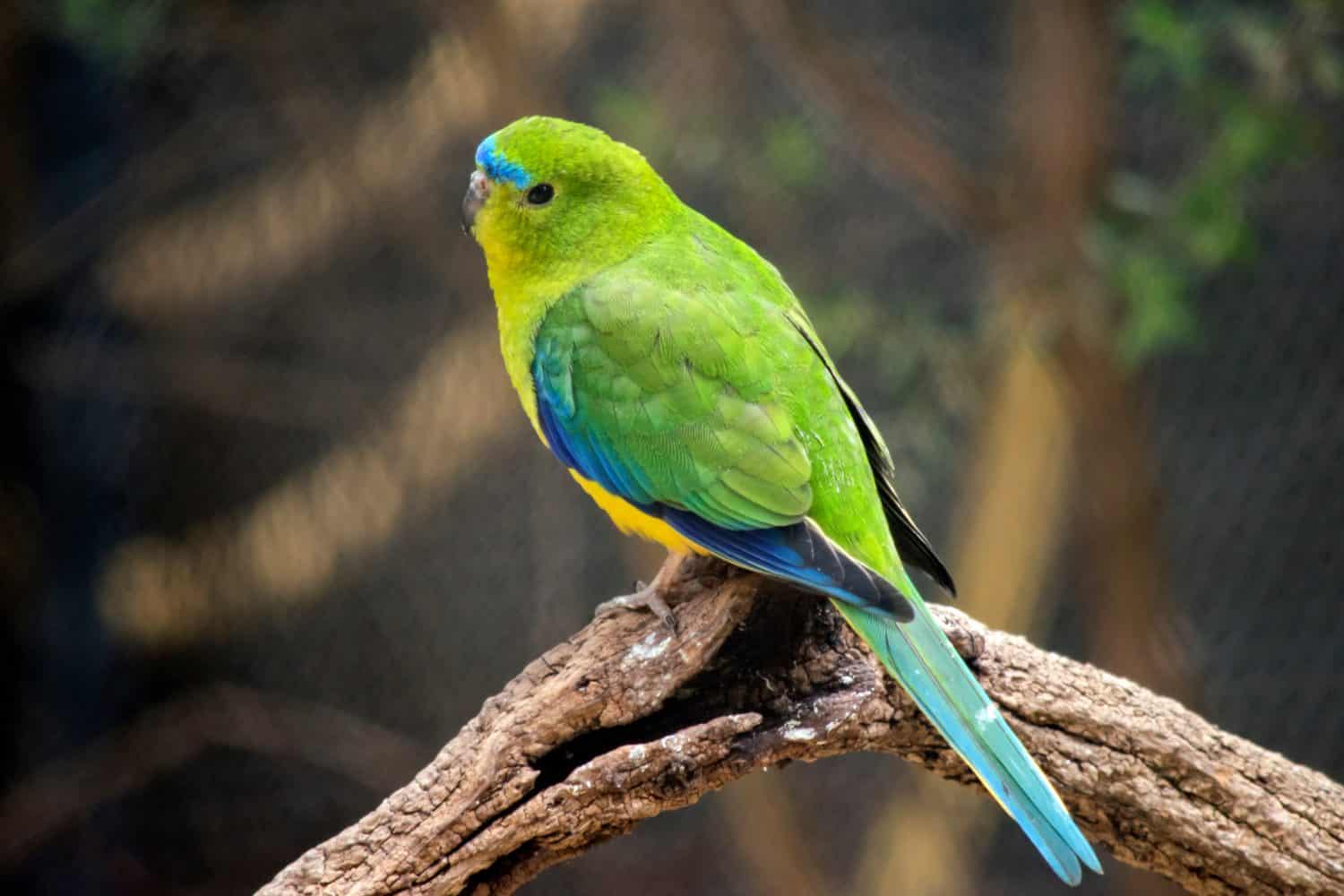
The Blue-winged parrot can reach up to 24 centimeters and weigh up to 55 grams.
©Susan Flashman/Shutterstock.com
The Blue-winged parrot has an olive-green upper body, a yellow-greenish face, a yellow belly, and dark-colored wings. The tails of these birds are bluish-grey. Blue-winged parrots are found in wetlands near coastal and semi-dry areas of Tasmania and Southern Victoria.
15. Rock Parrot
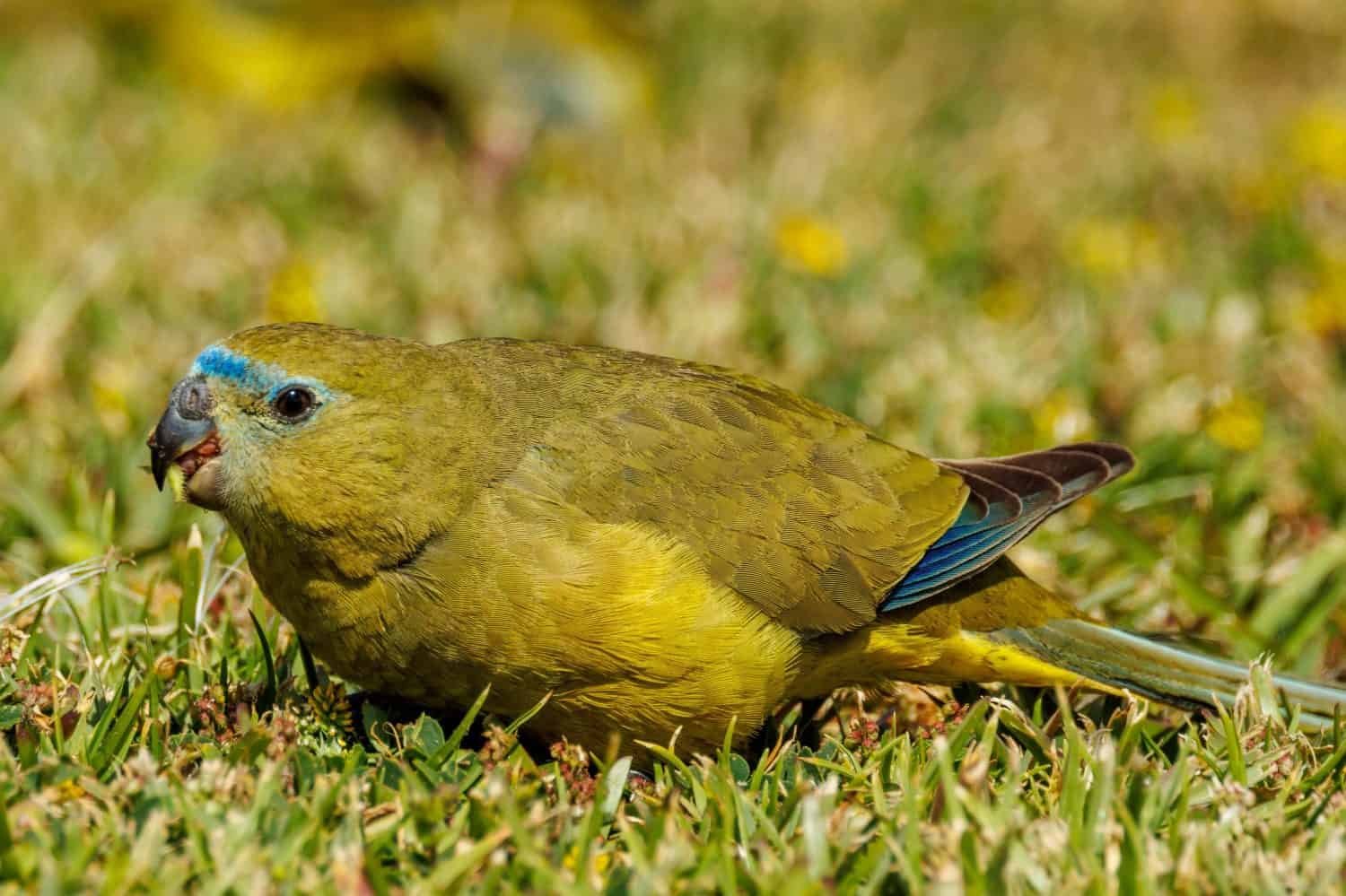
Rock parrots can grow up to 22 centimeters long and weigh up to 67 grams.
©Imogen Warren/Shutterstock.com
The Rock parrot lives on the rocky coastlines of south and west Australia. This stocky parrot has an olive-green body, a yellow belly, and a blue face. They also have a pale blue tail and yellowish undersides of their body.
16. Galah

Galahs can grow up to 38 centimeters long.
©Wirestock Creators/Shutterstock.com
Galah has a rose-pink head, neck, and undersides. They also have a pale pink crown, a grey back, wings, and undertail. These beautiful birds can breed with members of the cockatoo family. Galahs can be seen in parks and suburbs of Sydney.
17. Turquoise Parrot

The Turquoise parrot is typically 20 to 22 centimeters long.
©Lei Zhu NZ/Shutterstock.com
The Turquoise parrot has a turquoise blue crown and face, a bright green back, a yellow throat, chest, belly, and tail edges. Males have red-shoulder patches, whereas females do not. You may notice that as these birds age, their underparts are orange. These parrots are found in southeast Queensland and north-eastern Victoria. Their habitats consist of grassy open woodlands with dead trees near water.
18. Scarlet-chested Parrot

Scarlet-chested parrots are typically 19 to 21 centimeters.
©Eckhard Lietzow/Shutterstock.com
This type of parrot has bright green upperparts, a blue face, a throat, and cheeks. They also have a scarlet-colored chest, hence their name. Females have a paler complexion and a green-colored chest. These birds live in the open woodlands of southern inland Australia.
19. Little Corella

The scientific name of the Little Corella is
Cacatua sanguinea, meaning blood-stained Cockatoo.
©Rini Kools/Shutterstock.com
The Little Corella is the smallest in the Corella family and has a white body, blue eye ring, and dark pink mark between the eyes. These little birds are widespread in Australia and can grow up to 42 centimeters long.
20. Major Mitchell’s Cockatoo

This Cockatoo was named after Major Sir Thomas, an explorer of southeast Australia, in the 1800s.
©Eric Isselee/Shutterstock.com
The Major Mitchell’s Cockatoo is a medium-sized white bird with pink on the sides of their head, around the neck, and undersides. They also have red and yellow bands on their crest. You may see the Major Michell’s Cockatoo in semi-dry regions of Australia. This Cockatoo can reach up to 40 centimeters and weigh up to 450 grams.
21. Rainbow Lorikeet
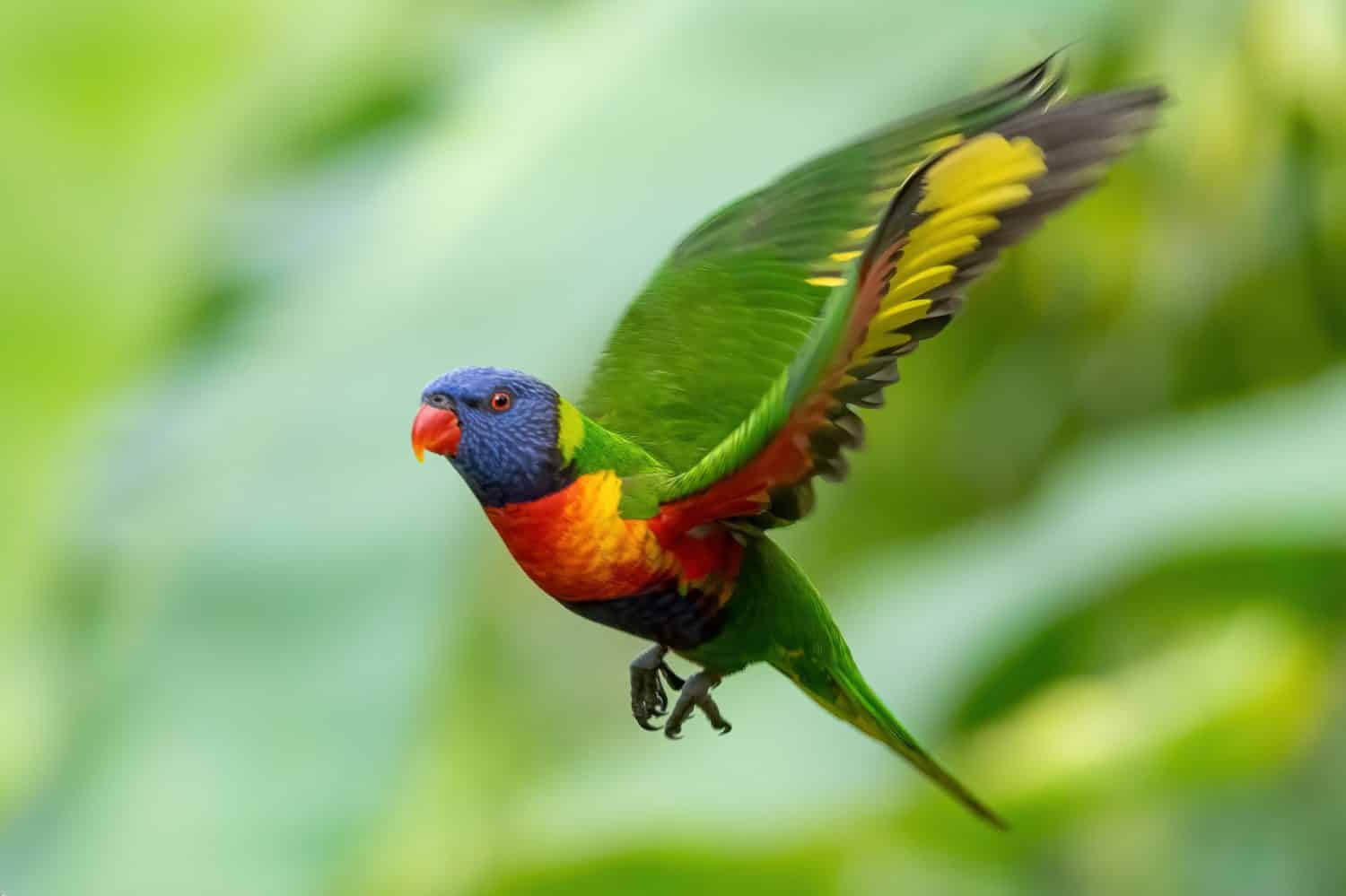
These birds can grow up to 32 centimeters long.
©whitejellybeans/Shutterstock.com
The Rainbow Lorikeet lives in the eastern seaboard, northern Queensland, and South Australia. These birds hang around forests and woodlands. Rainbow Lorikeets have a colorful body, hence their name, with a blue head.
22. Red-collared Lorikeet

Red-collared Lorikeets can grow up to 26 centimeters long.
©Danny Ye/Shutterstock.com
The Red-collared Lorikeet has a similar coloration to the Rainbow Lorikeet but has a red band on the back of its neck. You can find these birds in the woodlands of northern Australia, swamps, and suburban areas.
23. Scaly-breasted Lorikeet

The Scaly-breasted Lorikeet can grow up to 24 centimeters long.
©Orion Media Group/Shutterstock.com
The Scaly-breasted Lorikeet has a yellow chest and a green body, giving a scaly appearance on its chest. They also have red eyes and beaks. The scaly-breasted Lorikeet lives in forests on the eastern coast of Australia.
24. Little Lorikeet

You can find these birds in the forests of eastern and southern Australia.
©Susan Flashman/Shutterstock.com
The Little Lorikeet is very small, only reaching up to 15 centimeters in length. Little Lorikeets are green with red faces and have light brown coloration between the shoulders.
25. Musk Lorikeet
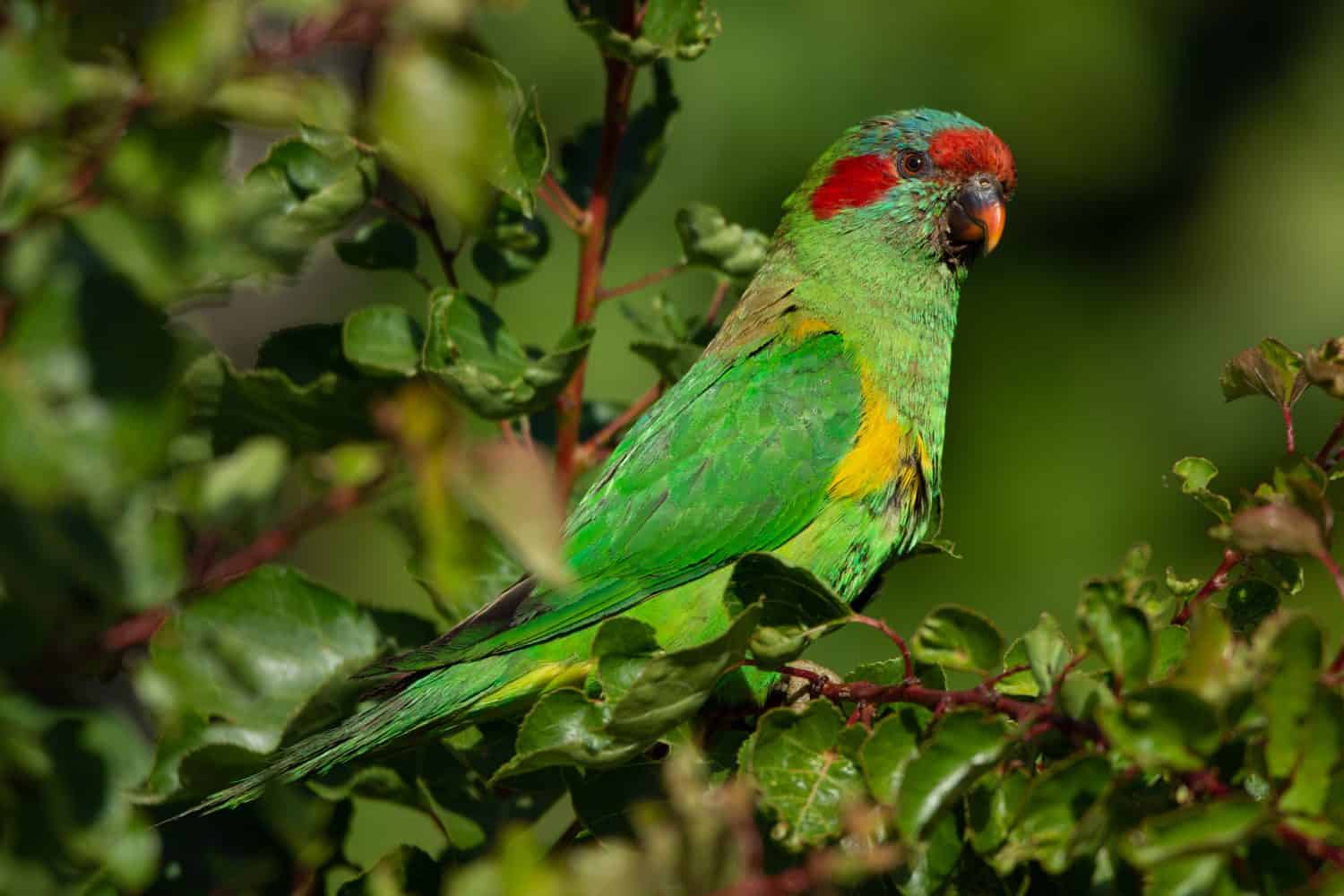
Musk Lorikeets can grow up to 22 centimeters long.
©Adrian Borg/Shutterstock.com
The Musk Lorikeet has a green body and a yellow patch on the side of its breast. You may notice their bright red foreheads and a red band between their eyes and ears. The Musk Lorikeet often flocks with the Rainbow Lorikeets in city parks. They also habitat in the dry forests and woodlands of southeastern Australia.
26. Purple-crowned Lorikeet

The Purple-crowned Lorikeet can grow up to 18.5 centimeters long.
©Martin Pelanek/Shutterstock.com
The Purple-crowned Lorikeet lives in southern and southwestern Australia’s open forests and woodlands. These birds are commonly seen on Kangaroo Island. This lorikeet has a green body with a bronze color across the nape and mantle. The feathers behind the ear and forehead are orangish-yellow.
27. Varied Lorikeet

The Varied Lorikeet can grow up to 19 centimeters.
©Andreas Ruhz/Shutterstock.com
The Varied Lorikeet is green with yellow streaks and a red crown. This lorikeet lives in northern Queensland and Western Australia. The Varied Lorikeet habitats in grasslands, wetlands, and tropical eucalyptus forests.
28. Sulphur-crested Cockatoo
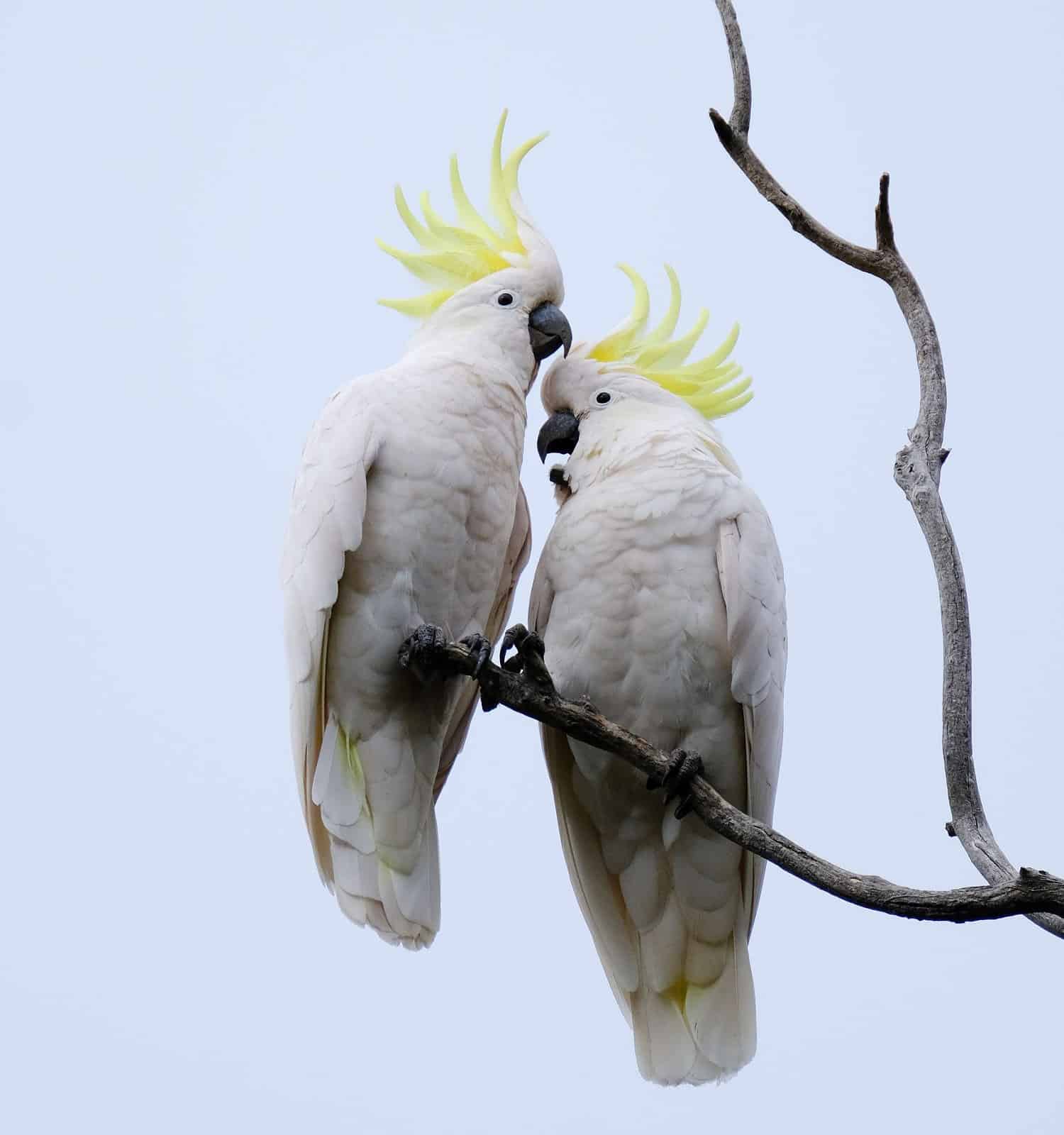
The Sulphur-crested Cockatoo can reach up to 50 centimeters long.
©Wirestock Creators/Shutterstock.com
The Sulphur-crested Cockatoo is a large white bird with a dark grey bill and sulfur-yellow crest. You can see this cockatoo on the eastern coastlines from Kimberley to Tasmania.
29. Long-billed Corella

The Long-billed Corella can grow up to 41 centimeters and weigh up to 567 grams.
©Jack Skeens/Shutterstock.com
The Long-billed Corella species lives in the southeast regions of Australia. You can observe these birds in the suburbs of Sydney, Royal National Park, Ku-ring-gai Chase National Park, and the Blue Mountains. This medium-sized bird is white, has a short crest and tail, and a long upper bill. Their forehead, throat, and upper breast are orangish-red.
30. Western Corella

Western Corellas can grow up to 48 centimeters long.
©Serge Goujon/Shutterstock.com
The Western Corella is similar to the Long-billed Corella but lives in the extreme southwestern regions of Australia.
31. Cockatiels
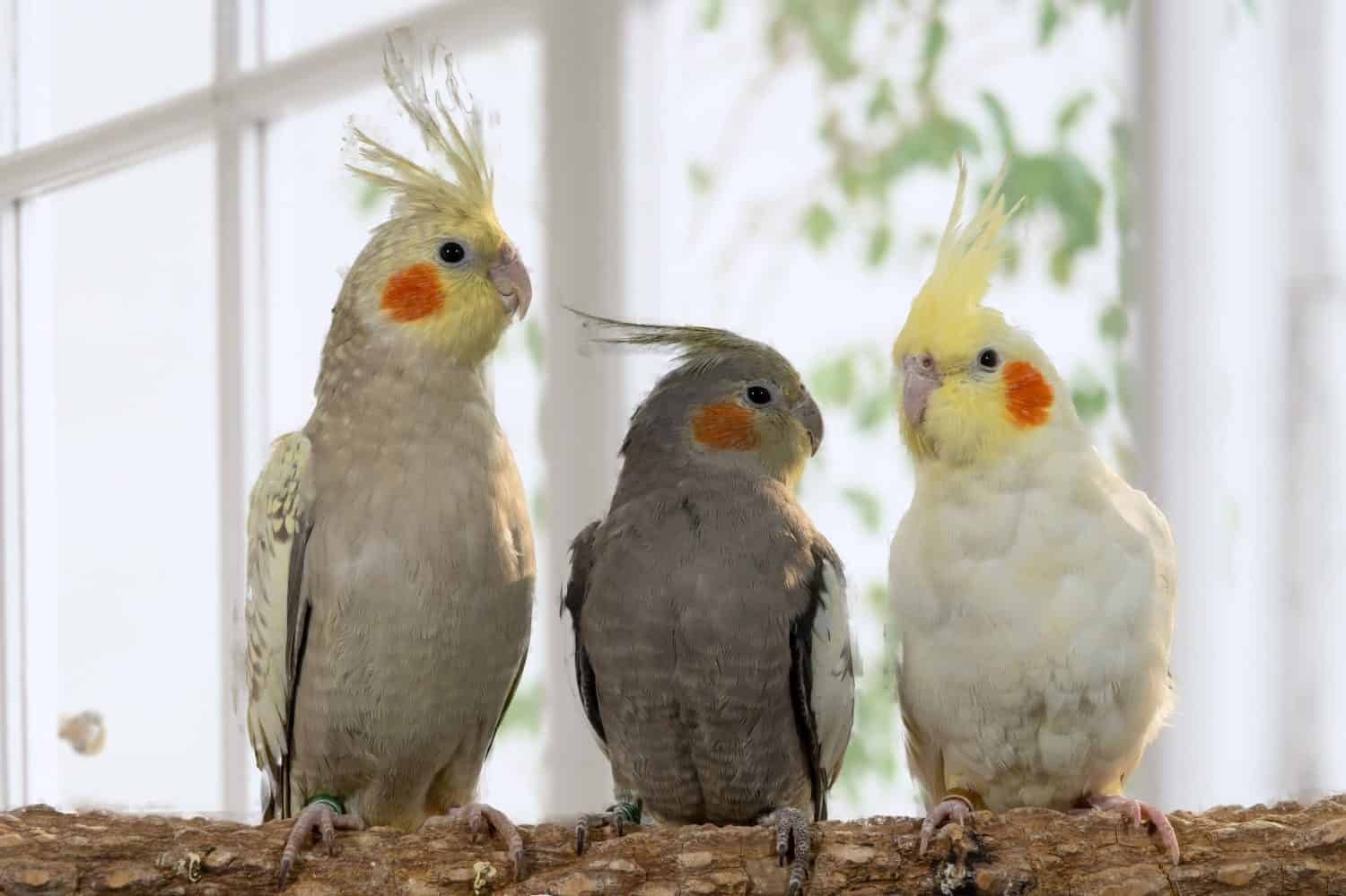
These birds are the smallest of the cockatoo family, reaching only 33 centimeters long.
©hai jiang/Shutterstock.com
Cockatiels are native to Australia and can be found in dry or semi-dry regions of Australia. These beautiful little birds can come in many colors but primarily have a greyish body with red-orange cheeks. They also have a yellow crest and tail.
32. Gang-gang Cockatoo

The Gang-gang Cockatoo can grow up to 37 centimeters long.
©David C Simon/Shutterstock.com
The Gang-gang Cockatoo is a small dark grey bird with white feather tips, a short square tail, and a redhead. Females have dark grey heads with a yellow-orange coloration on their breasts and belly. These birds live in Eucalypt woodland forests of southeastern Australia. You may also find these birds in Canberra and Mt Tomah Botanic Gardens.
33. Baudin’s Black Cockatoo

These cockatoos can reach up to 55 centimeters long.
©Imogen Warren/Shutterstock.com
The Baudin’s Black Cockatoo has a brownish-black body with white feathered tips. They also have white patches on their cheeks, white bars on the tail, and a pink rind around the eyes. Their bill is long and narrow. The Baudin’s Black Cockatoo can be found in heavily forested areas between Albany and Perth.
34. Carnaby’s Black Cockatoo

Carnaby’s Black Cockatoo can grow up to 58 centimeters long.
©Imogen Warren/Shutterstock.com
The Carnaby’s Black Cockatoo appears similar to the Baudin’s Black Cockatoo but has a short, wide bill. You can find these birds in southwest Australia between Cape Arid and Kalbarri.
35. Glossy Black Cockatoo
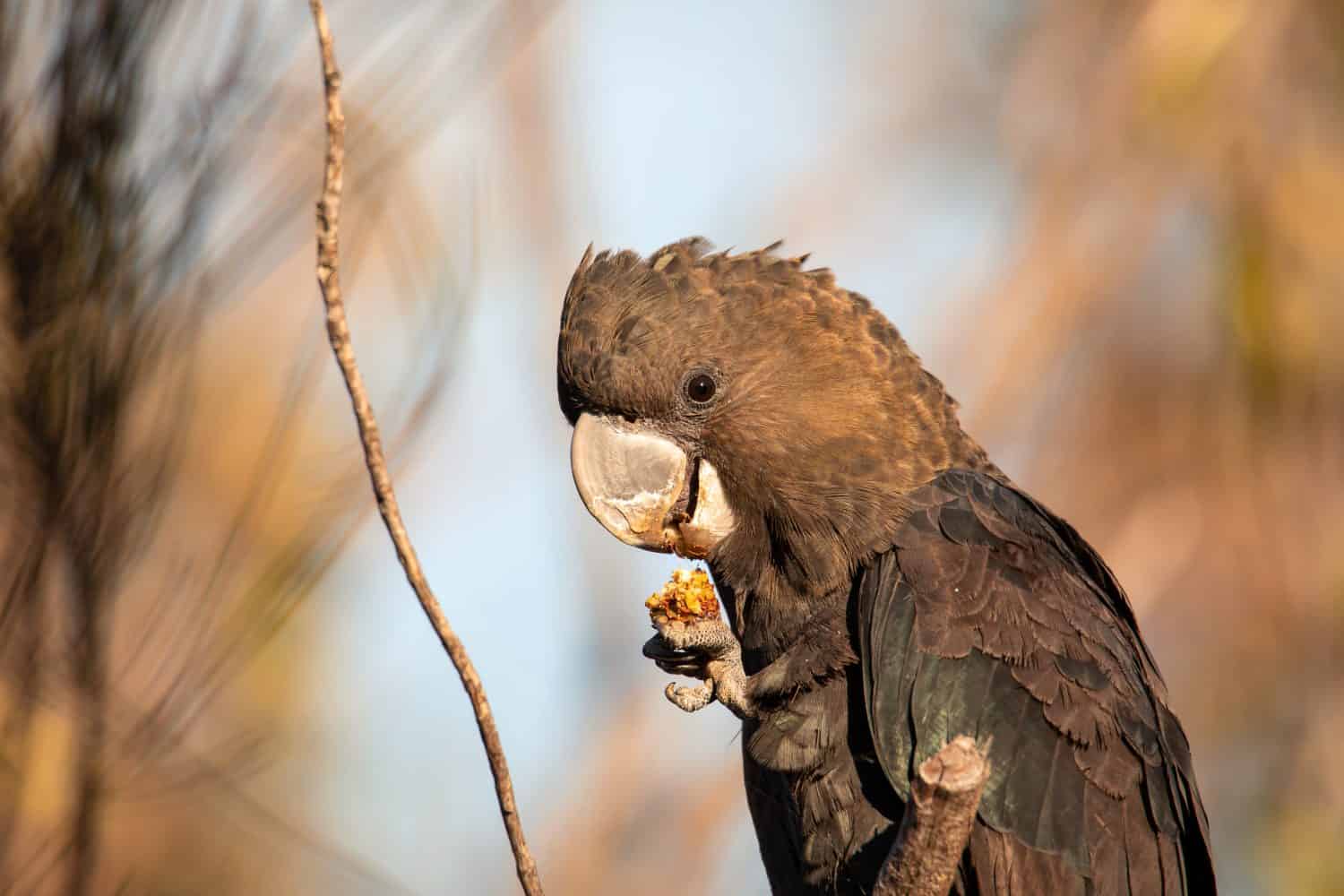
These birds are found in eastern Australia, southeast Queensland, east Victoria, and Kangaroo Island.
©Brayden Stanford Photo/Shutterstock.com
The Glossy Black Cockatoo is the smallest in the black cockatoo species, only reaching 50 centimeters long. This beautiful bird is black with a brownish-black head. The undersides of their tails can be either red or a mixture of red, orange, and yellow. Females have irregular yellow patches on their heads.
36. Palm Cockatoos

During the breeding season, Palm Cockatoos will drum on dead trees!
©DLeng/Shutterstock.com
Palm Cockatoos are native to the Cape York Peninsula. They can also be found in rainforests and woodlands in hollow trees. This large cockatoo is 60 centimeters long and has a lifespan of sixty years in the wild. The Palm Cockatoo is black with red cheeks and a long, beautiful crest.
37. Red-tailed Cockatoo

Red-tailed Cockatoos can grow over 60 centimeters long.
©Martin Tobias Aakesson/Shutterstock.com
The Red-tailed Cockatoo can be found in Eucalyptus forests and woodlands of northern parts of Australia. Males are glossy black with bright red bars on the underside of their tails. Females have orange-yellow bars on the underside of their tails and yellow spots on the head, neck, and wings.
38. Yellow-tailed Black Cockatoo

The Yellow-tailed Black Cockatoo can grow up to 60 centimeters long.
©Alex Cooper Photography/Shutterstock.com
The Yellow-tailed Black Cockatoo is commonly found in Sydney, Centennial Park, and Royal National Park. The body of this cockatoo is black, with yellow bars on the undersides of their tail and yellow cheeks. Females have a grey eye ring and white upper bill, whereas males have a pink eye ring and greyish-black bill.
| 38 Parrots in Australia |
| 1. Double-eyed Fig Parrot |
| 2. Eclectus Parrot |
| 3. Red-cheeked Parrot |
| 4. Australian King-Parrot |
| 5. Red-Winged Parrot |
| 6. Superb Parrot |
| 7. Regent Parrot |
| 8. Red-capped Parrot |
| 9. Swift Parrot |
| 10. Red-rumped Parrot |
| 11. Mulga Parrot |
| 12. Golden-shouldered Parrot |
| 13. Bourke’s Parrot |
| 14. Blue-winged Parrot |
| 15. Rock Parrot |
| 16. Galah |
| 17. Turquoise Parrot |
| 18. Scarlet-chested Parrot |
| 19. Little Corella |
| 20. Major Mitchell’s Cockatoo |
| 21. Rainbow Lorikeet |
| 22. Red-collared Lorikeet |
| 23. Scaly-breasted Lorikeet |
| 24. Little Lorikeet |
| 25. Musk Lorikeet |
| 26. Purple-crowned Lorikeet |
| 27. Varied Lorikeet |
| 28. Sulphur-crested Cockatoo |
| 29. Long-billed Corella |
| 30. Western Corella |
| 31. Cockatiels |
| 32. Gang-gang Cockatoo |
| 33. Baudin’s Black Cockatoo |
| 34. Carnaby’s Black Cockatoo |
| 35. Glossy Black Cockatoo |
| 36. Palm Cockatoos |
| 37. Red-tailed Cockatoo |
| 38. Yellow-tailed Black Cockatoo |
The photo featured at the top of this post is © Andrii Slonchak/Shutterstock.com
Thank you for reading! Have some feedback for us? Contact the AZ Animals editorial team.






